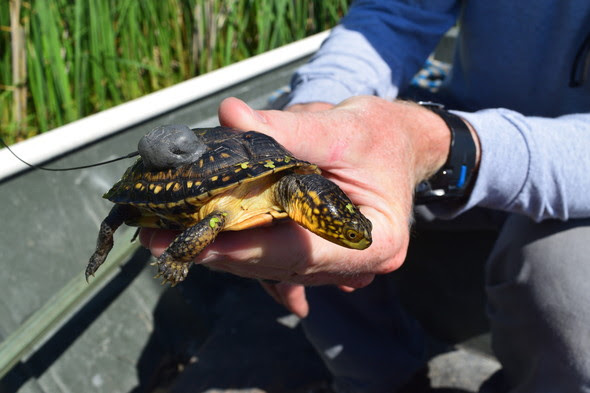The flat-bottomed boat noisily snaked through the narrow path through the towering cattails, its mud motor pushing it to a specific place in the marsh. On board, is a small but important passenger – a nearly year-old Blanding’s turtle outfitted with a battery powered tracking device about the size of a dime with a small antenna.

Blanding’s turtles are listed as threatened in Iowa, and the species is a candidate for listing federally due to its declining population caused by the loss of critical habitat and low nest success. Less habitat for nesting means the turtles nest close together, which can create a buffet for predators, or on road shoulders, making cars a predator, too.
By increasing the amount of preferred habitat, the turtles would spread out, avoid roads, and result would be a higher likelihood that some nests will be successful.
Blanding’s turtles look sort of like a 1940s German-style leather half face style motorcycle helmet. Their domed, dark grayish/black shell with their bright yellow chin and underside of their neck makes them 100 percent identifiable. No other turtle in Iowa has that bright yellow chin and underside.
They prefer wetlands of all sorts and one turtle will use several different wetlands each year for different purposes, like hibernating, feeding and mating, and like those wetlands to have good plants in them. Generations ago, these wetlands would have been found in nearly every county, but, over time, as the wetlands disappeared, those populations were separated and died out.
This turtle is fortunate – it spent its first 11 months eating and growing in a protected environment at the University of Northern Iowa (UNI) in the lab of Dr. Jeff Tamplin, growing to the size of a three to four-year-old turtle in the wild. It was released along with the other surviving hatchling in early June to the same marsh where its mother was found last year.
This yearling turtle was one of two survivors out of 20 eggs the female was carrying. It was later determined that most of the eggs were not fertilized.
On this hot July afternoon, Emily Asche eases the boat into the mire to release the little turtle where she found it the day before.
Asche, a seasonal employee for the DNR, is tracking five adults with transmitters here, two females and three males – in addition to the hatchlings.
“We outfitted the adult female and two hatchlings with tracking devices to follow their movement and learn more about their range and the habitats they use at different times of the year, in the hopes of recreating more of their preferred habitat,” said TJ Herrick, wildlife biologist for the Iowa DNR.
Tracking devices on the adults can last eight to nine years, he said. The batteries on the hatchlings will need to be replaced after a few months because the devices are much smaller, not exceeding three percent of the turtle’s body weight.
Herrick said they found another female this June which was carrying 17 eggs, and tracked her until her movements indicated she was nesting. These turtles move up to a mile away from the marsh to nest, usually along a field edge where she will dig a hole in the dirt and lay the eggs before she returns to the wetlands, leaving the eggs to develop alone.
They found the nest, covered it was wire fencing on the four sides and top, and placed a camera to watch it for the young to emerge.
Blanding’s turtle incubation period and sex are determined by temperature. The warmer the temperature, the shorter the incubation period (50 days), the cooler, the longer (128 days). Temperature above 87 degrees, hatchlings will be female. Temperature in the middle 70s, hatchlings will be male.
Herrick said they are tracking the soil temperature daily to have an idea when the eggs will hatch and the likely female to male ratio. “We’re hoping for more females,” he said.
This isn’t the only study on Blanding’s turtles underway.
The Iowa DNR is partnering with other organizations, like Blank Park Zoo and Iowa State University, to collect data on Blanding’s at different locations in an effort to better understand habitat needs, and then incorporate that information into management practices.
Life as a turtle isn’t easy. In the wild, Blanding’s face long odds – from skunks and raccoons raiding nests for the eggs, to snapping turtles and cranes feeding on the hatchlings during the first few years of life. Females don’t begin to reproduce until age 18-20; males at age 14-15. However, these turtles can live to nearly 80 years old and their reproductivity grows as it ages, meaning the oldest turtles have the biggest clutches.
If a Blanding’s turtle is encountered, take a photo and leave it on its way. If it’s encountered on the road, it is acceptable to help it cross in the direction it is heading. Blanding’s turtles are protected and it is illegal to collect one as a pet or to kill it.